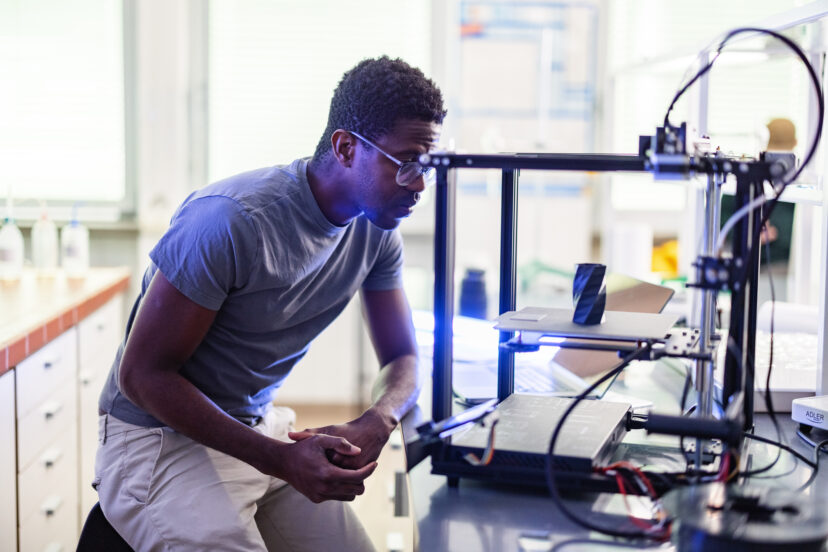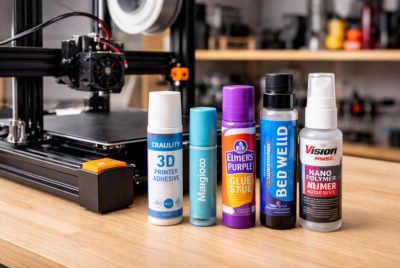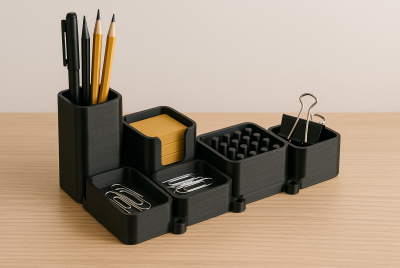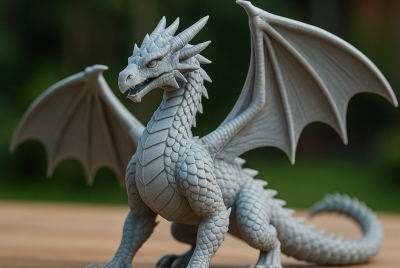Big 3D Printer: What You Need to Know Before You Buy
Do you enjoy making brilliant ideas into physical objects? Same here! But hey, before jumping into your next big 3D printing project, it’s important to know what a big 3D printer is. These power printers are widely used in manufacturing, full-size prototyping, art, and DIY projects (that regular 3D printers can’t handle). Let me walk you through everything you should know about a larger-than-life version of a tool and unravel its essentials.
What Defines a Big 3D Printer?
How do you know that it’s a big 3D printer? Well, it all comes down to build volume. Build volume is the maximum size (or the largest space the printer can use) a 3D printer can make to create a single object at once. Typically, a standard printer gives you around 200 x 200 x 200 mm workspace, enough for printing toys and small objects. The big 3d printer, on the other hand, reaches up to an incredible 1000 mm in one dimension. Meaning, you can print bigger and bolder objects like furniture and car parts!
Who Needs a Big 3D Printer?
Is bigger always better? No guys, not really. Big 3D printers aren’t for everyone. Why? Because these giants cater to those who need that extra build space. For example, industrial manufacturers, businesses that need modern signage, and artists crafting furniture. But if you’re a hobbyist dreaming of taking on bigger projects, you could give it a try.
The Growing Impact of Large-Scale 3D Printing in Industry
Large-scale 3D printing is gaining traction across various industries, driven by the potential for customized production and cost-saving opportunities. A market analysis highlights the projected growth of this sector, emphasizing the increasing demand for innovative manufacturing solutions. Meanwhile, research on construction applications shows that 3D printing can drastically reduce both construction time and labor costs, enabling unique architectural designs that traditional methods struggle to achieve.
Big Printers vs. Standard 3D Printers: The Differences
Now let’s talk about the difference between the two 3d printers. More than the size difference (which is obvious I guess), big 3D printers come with beefier frames, more sophisticated components, and often upgraded cooling systems. Meaning, you’ll likely need more power to run one. Oh, and did I mention that they can be louder too? Yeah, that’s right. Are you ready to hear that hum of productivity at full scale? Just remember, sometimes, bigger printers comes with bigger problems too so be ready for that, folks.
Advantages of Owning a Big 3D Printer
What’s the appeal of going big? Let’s explore some standout perks:
- One-Piece Wonders: Larger models mean you can print sizable pieces in one go—no glue, no screws, no assembly.
- Time Saver: Big printers cut down on assembly time, so those hours piecing things together turn into hours watching your creation take shape.
- High-Quality Builds: Many big 3D printers come with pro-level components that give you top-notch results.
Top Big 3D Printers to Consider
With a generous build volume of 450 x 450 x 470 mm, the CR-10 Max is built for those big ideas. It comes with a dual power supply, automatic bed leveling, and a sturdy triangle frame that adds stability. Affordable and reliable, it’s a solid choice for anyone looking to explore large-format 3D printing without spending a fortune.
The Kobra 2 offers a roomy 400 x 400 x 450 mm print area, paired with a user-friendly touchscreen and a heated bed. It’s budget-friendly yet packed with essential features, making it a great pick for beginners eager to dive into large-scale printing without stretching their budget.
With a print volume of 300 x 300 x 400 mm, the Artillery Sidewinder X2 comes with resonance compensation technology to cut down on vibrations and improve accuracy. Known for its quiet operation and smooth, direct-drive extruder, this model is perfect for users who need precise, high-quality prints without the noise.
Offering a more compact build space of 220 x 220 x 250 mm, the Creality K1C is all about efficiency and speed. It features a clog-free extruder and a robust frame, making it a top pick for users focused on fast, high-quality prints. Its extruder is designed to prevent clogging, giving you a smoother printing experience.
With its 300 x 410 mm build volume and unique Delta design, the FLSUN V400 combines high speed with precision. It includes a big touchscreen, and a quiet direct drive extruder, and is perfect for complex projects that need smooth, rapid curves. Its design allows for faster movement, making it ideal for intricate, high-detail prints.
Potential Downsides of Big 3D Printers
Every big advantage has a flip side, and here’s where the challenges lie:
- The Price of Size: Bigger printers come with heftier price tags.
- Power Hungry: Prepare for these machines to consume more energy, which might show up on your electric bill.
- Room to Breathe: They take up serious space, so clear out that corner or workshop for their arrival.
Materials Compatible with Big 3D Printers
Big 3D printers generally play nice with the same materials as smaller ones—think PLA, ABS, PETG. But some can handle more advanced materials like carbon fiber, nylon, and other durable filaments that transform the strength and longevity of your projects. Ready to level up?
Types of Big 3D Printers Available
Big 3D printers come in a few main types, each with unique pros:
- FDM (Fused Deposition Modeling): This common type is often the most budget-friendly for large-scale projects.
- SLA (Stereolithography): Resin-based, SLA is excellent for intricate details, though it can cost a pretty penny.
- SLS (Selective Laser Sintering): Used in industrial applications, SLS printers offer impressive strength and detail, a favorite for professionals.
Important Features to Look for in a Big 3D Printer
Not every big printer is cut from the same cloth. Here’s what to watch for:
- Layer Resolution: Adjustable resolution lets you control the smoothness of your print.
- Automatic Bed Leveling: This feature saves you a lot of setup headaches.
- Dual Extruders: Perfect for mixing materials or colors in one print.
The Role of Nozzle Size in Big 3D Printers
Ah, the nozzle. The one that handles the extrusion of filament material. That said, size is very important here. It can make or break the efficiency of a print. Bigger nozzles speed things up but can skimp on detail; smaller ones slow things down but add that fine touch. Which one should you use? Well, that depends on what works for you.
Tips on Managing Heat and Warping Issues
Bigger prints mean hotter temperatures. And believe me, it’s quite challenging!!! If it becomes too hot, it can lead to surface defects. That;s why heated beds and enclosed chambers work wonders for keeping your creation consistent. Some users even craft their own enclosures to beat warping, especially with tricky filaments like ABS.
Choosing the Right Filament for Your Big 3D Printer
Each filament has its quirks. Personally, I like to use PLA because it’s user-friendly and less likely to warp. But you can also use ABS. The only thing you need to consider is that ABS demands a heated bed to avoid curling. And let’s be honest, it has a learning curve. But once you’ve got the hang of it, there’s a filament for every project’s needs.
Understanding Print Speed vs. Quality
Speed or detail? Do you really have to choose between the two? Nope. It’s a balance. Sure, s fast print might get the job done quickly but it can sacrifice some polish. Surprisingly, slower prints reward your patience with high-quality finishes. So, what’s more valuable to you—time or perfection? I don’t mind waiting longer if it means I don’t have to repeat the process over again!
Maintenance Tips for Your Big 3D Printer
Keeping your printer in peak condition is worth the effort. Here are some maintenance basics:
- Lubricate Regularly: Big printers have more moving parts, so keep them well-oiled.
- Check the Alignment: With more components, things can shift. Regularly check alignment.
- Clean the Build Plate: A spotless surface helps your prints stick and reduces warping.
Cost Considerations: How Much Should You Spend?
Now about the price, Big 3D printers range widely, from a few thousand to tens of thousands of dollars. Of course, expect it to be a bit costly since it has a bigger build volume than a regular printer. What do you really need? If you’re not planning to print bigger projects then choose a smaller size printer instead.
Recommended Big 3D Printer Brands
Ready to print bigger, bolder designs? Awesome!!! If you’re ready to dip your toes on big 3d printers, choose a reliable brand with positive reviews. Brands like Anycubic and Formlabs have earned a reputation for quality in the large 3D printer space. Look for reliability, durability, and top-notch customer support as key indicators.
Comparing Software Compatibility
Most big 3D printers support slicer software like Cura or PrusaSlicer, though certain printers might work best with specialized software. That’s fine, just do your homework and research the software that fits your specific model to optimize performance. Printers like Anycubic also have free 3d slicer software which is great!
How Long Does it Take to Print on a Big 3D Printer?
Buckle up and brace yourself—big prints need time. Now don’t be surprised, folks! Even at high speeds, you’re likely looking at hours, sometimes days. That’s alright, you can just sit back and relax while waiting for your masterpiece. I suggest you set your expectations, especially for intricate designs.
Safety Tips for Big 3D Printers
Listen up, safety matters especially with a big 3d printer. Ventilation is crucial, as some filaments release fumes. Keep the area free of flammables, wear protective gear if necessary, and have a fire extinguisher close at hand. Keep safe, always!
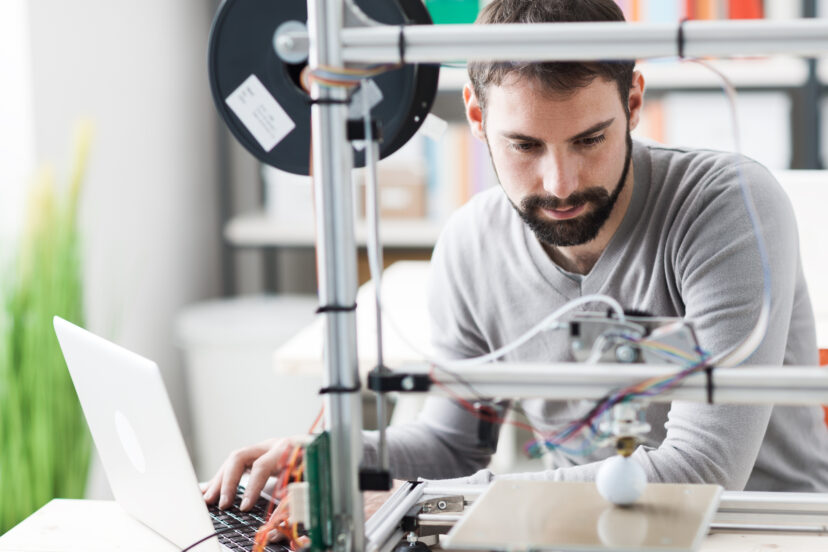
The Future of Big 3D Printers: What’s Next?
The trend is clear: big 3D printers are here to stay for a long long time. With innovations in material variety, printing speed, and multi-axis capabilities? We may soon see a new wave of possibilities, from complex sculptures to high-end industrial models. Who knows if 3d bioprinting can happen in the near future?
Conclusion: Is a Big 3D Printer Right for You?
A big 3D printer is perfect for anyone looking to scale up their creations. Want to print furniture? Prototypes? Car parts? You name it. They bring your ambitious ideas to life! Watching a large 3D model emerge, layer by layer, is its own kind of magic although it may take more time than a regular printer. Think you’ve got the space and the budget? Upgrade your 3d printer now!
FAQS
1. Do big 3D printers require special filaments?
No, but they tend to handle certain filaments better. While PLA is a go-to, advanced users may prefer ABS or nylon for added durability.
2. Can a big 3D printer print smaller items too?
Absolutely. Although designed for large builds, they’re fully capable of handling smaller projects—it just may take a bit longer.
3. Is it difficult to assemble a big 3D printer?
Some models are plug-and-play, while others require assembly. The setup can be challenging, but with detailed instructions, you’re covered.
4. Are big 3D printers safe to use at home?
Yes, provided you take safety precautions like ensuring ventilation and monitoring the machine during operation.
5. What’s the biggest challenge with big 3D printers?
Warping and temperature management are common hurdles. A heated bed and enclosed setup can work wonders in minimizing these issues.

